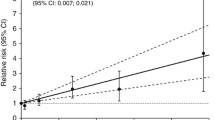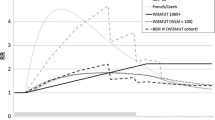Abstract
Not until about 1970 was it possible to estimate the magnitude of the correlation between additional lung cancer frequency and radon daughter exposure in miners. In addition, it has been realised that high levels of radon daughters in homes may be found in all countries and therefore the interest, in radon in buildings has rapidly increased during the last 10 years.
Radon gas enters the house from underground, from building materials and in some cases from tap water. Indoor radon daughter concentrations vary between countries and regions. The absorbed dose in the basal cells of the bronchial epithelium based on an average of the population in, Canada, U.S.A. and West Germany can be estimated to be about 1 mGy a−1 (average radon daughter concentration about 25 Bq m−3) for Great Britain about half of that value and for the Nordic countries about double this value.
300–3000 lung cancer cases (most probable 1100) may occur in the future in the Swedish population of 8.4 million from radon daughter exposure indoors today. This estimation is made by the National Institute of Radiation Protection. A lower estimate of 100–1000 lung cancer cases is made by the Swedish Cancer Committee.
Efforts to decrease the exposure from radon daughters indoors have been made in some countries by establishing limits or recommendations for the radon or radon daughter concentration indoors. Measuring methods for finding houses with high radon daughter concentrations and effective building techniques in order to decrease the radon daughter concentrations in both existing and for planned buildings are available.
Similar content being viewed by others
References
Ludewig P, Lorenser S: Untersuchungen der grubenluft in den Schneeberger Gruben auf den Gehalt an Radiumemanation.Z Physik 22, 178 (1924).
Lundin F E, Wagoner J K, Archer V E: Radon daughter exposure and respiratory cancer, quantitative and temporal aspects. U.S. Department of Health, Education and Welfare, National Institute for Occupational Safety, and National Institute of Environmental Health Sciences, joint monograph 1 (1971).
Swedish Committee on measures against radiation hazards in buildings, etc.: Radon in housing, Report SOU 1983:6, Swedish Ministry of Agriculture. Stockholm, Liber (1984) (in Seedish). Part of the report is translated in Report a 84-10, National Institute of Radiation Protection, Stockholm (1984).
Castrén O, Mäkeläinen I, Winqvist K, Voutilainen A: Indoor radon measurements in Finland: a status report, in Hopke P K (ed):Radon and Its Decay Products, Occurrence, Properties and Health Effects, ACS Symposium Series,331, pp. 97–103. Washington DC, American Chemical Society (1987).
Stranden E: Radon-222 in Norwegian dwellings, in Hopke P K (ed):Radon and Its Decay Products, Occurrence, Properties and Health Effects, ACS Symposium Series331, pp. 70–83. Washington DC, American Chemical Society (1987).
Swedjemark G A, Mjönes L: Exposure of the Swedish Population to Radon Daughters, in Berglund B, Lindvall T, Sundell J (eds):Proceedings of the 3rd International Conference on Indoor Air Quality and Climate, Vol. 2, pp. 37–43. Stockholm, Swedish Council for Building Research (1984).
Nero A V, Schwehr M B, Nazaroff W W, Revzan K L: Distribution of airborne Radon-222 Concentrations in U.S. Homes. Lawrence Berkeley Laboratory Report LBL-18274 (1984) in George A C:Measurement of Sources and Air Concentrations of Radon and Radon Daughters in Residential Buildings. Presented at the American Society of heating, Refrigerating and Air-Conditioning Engineers Semiannual Meeting, Honolulu (1985).
McGregor R G, Vasudev P, Letourneau E G, McCullough R S, Prantl F A, Taniguchi H: Background concentrations of radon and radon daughters in Canadian homes.Hlth Phys,39, 285 (1980).
Bestimmung der Strahlenbelastung der Bevölkerung durch radon und dessen kurzlebige Zerfallsprodukte in Wohnhäusern und im Freien. Kernforschungszentrum Karlsruhe. Kfk 3805 (1985).
Wrixon A D, Brown L, Cliff K D, Driscoll C M H, Green B M R, Miles J C H: Indoor Radiation Surveys in the U.K.,Radiat Protec Dosim 7, 321 (1984).
Hultqvist B: Studies on naturally occurring ionizing radiations, with special reference to radiation doses in Swedish houses of various types.K svenska Vetensk Akad Handl, Ser 4, Band 6, no. 3, Stockholm (1956).
Swedjemark G A, Burén, A, Mjönes L: Radon levels in Swedish homes: a comparison of the 1980s with the 1950s, in Hopke P K (ed):Radon and Its Decay Products, Occurrence, Properties and Health Effects, ACS Symposium Series331, pp. 84–96. Washington DC, American Chemical Society (1987).
Nuclear Energy Agency, Organization for Economic Cooperation and Development: Dosimetry aspects of exposure to radon and thoron daughter products, Report by a NEA Group of Experts, Paris (1983).
United Nations Scientific Committee on the Effects of Atomic Radiation: Report to the General Assembly. Ionizing Radiation: Sources and Biological Effects (1982).
International Commission on Radiological Protection: Principles for limiting exposure of the public to natural sources of radiationAnns Int Comm Radiol Protec 14 (1) (1984).
International Commission on Radiological Protection: Recommendations.Anns Int Comm Radiol Protec 1 (3) (1977).
James A C: A reconsideration of cells at risk and other key factors in radon daughter dosimetry, in Hopke P K (ed):Radon and Its Decay Products, Occurrence, Properties and Health Effects. ACS Symposium Series331, pp. 400–418. Washington DC, American Chemical Society (1987).
Axelson O, Edling C, Kling H: Lung cancer and residency: a case-referent study on the possible impact of exposure to radon and its daughters in dwellings.Scand J Work envir Hlth 5, 10 (1979).
Simpson S, Comstock G: Lung cancer and housing characteristics.Arch envir Hlth 38, 248 (1983).
Edling C, Kling H, Axelson O: Radon in homes—a possible cause of lung cancer.Scand J Work envir Hlth 10, 25 (1984).
Pershagen G, Damber L, Falk R: Exposure to radon in dwellings and lung cancer: a pilot study, in Berglung B, Lindvall T, Sundell J (eds):Proceedings of the 3rd International Conference on Indoor Air Quality and Climate, vol. 2, pp. 73–78. Stockholm, Swedish Council for Building Research (1984).
Lanctot E M:Radon in the domestic environment and its relationship to cancer. State University of New York, Stony Brook (1985).
Damber L: Lung cancer in males—an epidemiological study in northern Sweden with special regard to smoking and occupation. Doctoral dissertation, Department of Oncology, University of Umeå (1986).
Svensson C, Eklund G, Pershagen G: Indoor exposure to radon from the ground and bronchial cancer in women.Int Arch Occup envir Hlth 59, 123, (1987).
United States Environmental Protection Agency: A Citizen's Guide to radon, what it is and what to do about it. Report OPA-86-004, U.S. Department of Health and Services (1986).
Swedish Committee on measures against radiation hazards in buildings, etc.: Preliminary proposal for measures against radiation hazards in buildings. Swedish Ministry of Agriculture, Report No. Ds Jo 1979:9, Stockholm, Liber (1979) (in Swedish).
Cohen B L: Failures and critique of the BEIR III lung cancer risk estimates.Hlth Phys 42, 267 (1982).
BEIR:The effects on populations of exposure to low levels of ionizing radiation, Washington DC, National Academy of Sciences (1980).
United States National Council on Radiation Protection and Measurements: Exposure from the uranium series with emphasis on radon and its daughters. Recommendations. NCRP Report No. 77 (1984).
Jacobi W: Possible lung cancer risk from indoor exposure to radon daughters.Radiat Protec Dosim 7, 395 (1984).
Swedish Cancer Committee: Cancer, causes, prevention, etc. Ministry of Health and Welfare, Report SOU1984:67. Stockholm, Liber (1984) (in Swedish).
The Radiation Protection Institutes of Denmark, Finland, Iceland, Norway and Sweden:Naturally Occurring Radiation in the Nordic countries—Recommendations (1986).
World Health Organisation: Indoor air quality: radon and formaldehyde, Report on a WHO-meeting. Environmental Health Series 13 (1986).
National Board, of Health and Welfare: The Ordinance Issued by the National Swedish Board of Health and Welfare with Advice and Instructions Concerning Measures to be Taken on Account of Radon in Dwellings, SOSFS(M) 1980:71. Stockholm (1980) (in Swedish).
National Board of Physical Planning and Building: Swedish Building Code, Stockholm (1980) (in Swedish).
Finnish Radon Commission: Final Report. Helsinki, Finnish Centre for Radiation and Nuclear Safety (1982).
Atomic Energy Control Board:Criteria for Radioactive Clean-up in Canada. Information bulletin 77-2, Ottawa (1977).
U.S. Environmental Protection Agency: Environmental protection standards for uranium mill tailings.Fed Reg 45, p. 27, 374 (22 April 1980). Washington DC, U.S. Government Printing Office (1980).
U.S. Environmental Protection Agency: Recommendations to State of Florida regarding Florida phosphate lands,Fed Reg 44, pp. 38, 665 (2 July 1979), Washington DC, U.S. Government Printing Office (1979).
Clavensjö B, Kumlin H: Radon in Dwellings, Building Technique Measures in New and Rebuilding, Report R90:1984, Stockholm, Swedish Council for Building Research (1984) (in Swedish).
Ericson S-O, Lindvall T, Månsson L-G: Indoor ionizing radiation, technical solutions and remedial strategy, Report D7:1986. Stockholm, Swedish Council for Building Research (1986).
National Board of Physical Planning and Building: Radon: planning, building licences and protection measures, Report 59. Stockholm (1982) (in Swedish).
Author information
Authors and Affiliations
Rights and permissions
About this article
Cite this article
Swedjemark, G.A. Radiation doses from radon in buildings. Med. Oncol. & Tumor Pharmacother. 4, 139–150 (1987). https://doi.org/10.1007/BF02934510
Received:
Accepted:
Issue Date:
DOI: https://doi.org/10.1007/BF02934510




